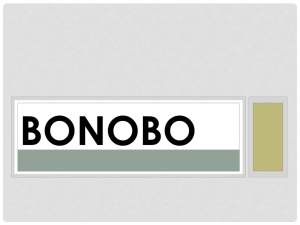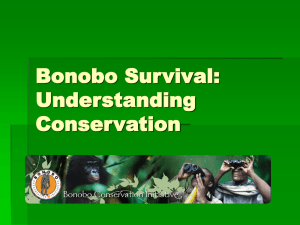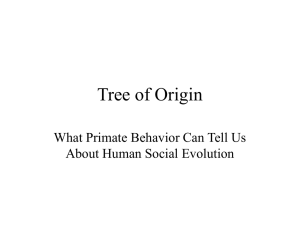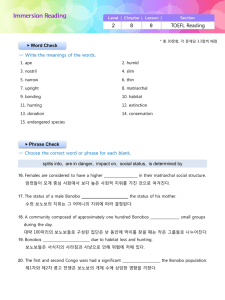Lesson Plans and Resources - Bonobo Conservation Initiative
advertisement
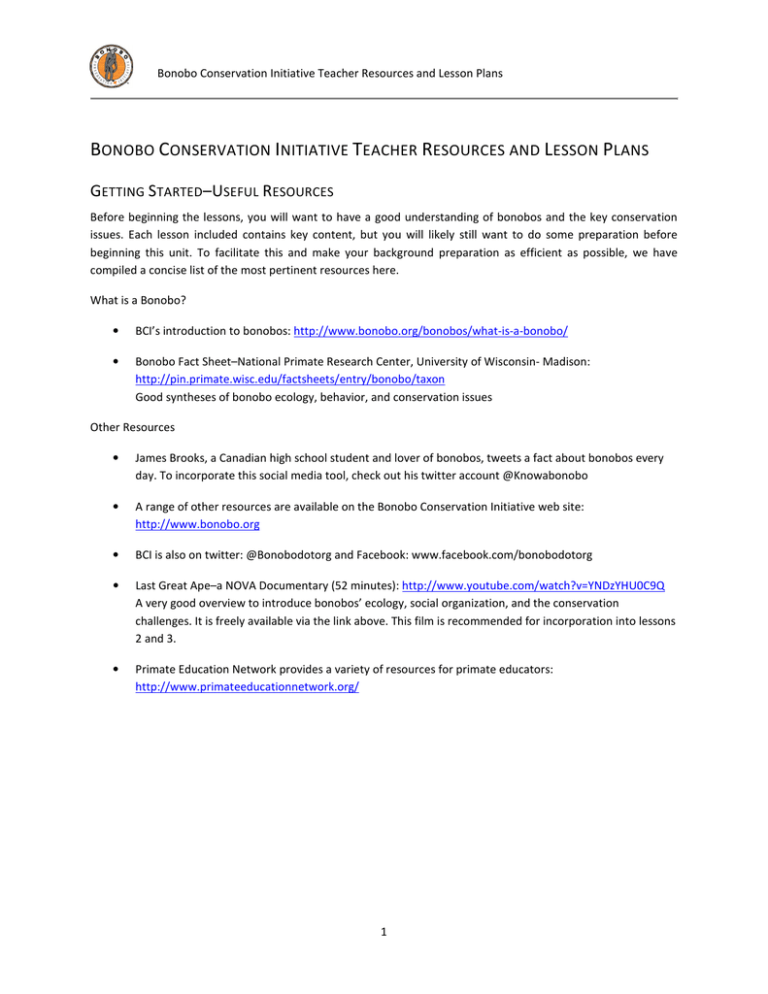
Bonobo Conservation Initiative Teacher Resources and Lesson Plans BONOBO CONSERVATION INITIATIVE TEACHER RESOURCES AND LESSON PLANS GETTING STARTED–USEFUL RESOURCES Before beginning the lessons, you will want to have a good understanding of bonobos and the key conservation issues. Each lesson included contains key content, but you will likely still want to do some preparation before beginning this unit. To facilitate this and make your background preparation as efficient as possible, we have compiled a concise list of the most pertinent resources here. What is a Bonobo? • BCI’s introduction to bonobos: http://www.bonobo.org/bonobos/what-is-a-bonobo/ • Bonobo Fact Sheet–National Primate Research Center, University of Wisconsin- Madison: http://pin.primate.wisc.edu/factsheets/entry/bonobo/taxon Good syntheses of bonobo ecology, behavior, and conservation issues Other Resources • James Brooks, a Canadian high school student and lover of bonobos, tweets a fact about bonobos every day. To incorporate this social media tool, check out his twitter account @Knowabonobo • A range of other resources are available on the Bonobo Conservation Initiative web site: http://www.bonobo.org • BCI is also on twitter: @Bonobodotorg and Facebook: www.facebook.com/bonobodotorg • Last Great Ape–a NOVA Documentary (52 minutes): http://www.youtube.com/watch?v=YNDzYHU0C9Q A very good overview to introduce bonobos’ ecology, social organization, and the conservation challenges. It is freely available via the link above. This film is recommended for incorporation into lessons 2 and 3. • Primate Education Network provides a variety of resources for primate educators: http://www.primateeducationnetwork.org/ 1 Bonobo Conservation Initiative Teacher Resources and Lesson Plans LESSON PLANS Lesson 1–What is a bonobo? This presentation is a foundational introduction to bonobos. Objectives: • To introduce students to the basic biological data on bonobos. • To engage students in active learning and pique their interest. Approximate length: 45 minutes Materials needed: • Power point presentation included, along with teacher notes. Download presentation here: http://www.bonobo.org/news-knowledge/teacher-resources/ • If no presentation equipment is available, notes can serve as the basis for a guided discussion • Flip-chart paper or dedicated space on the board which can remain un-erased for a few days Lesson 2 and 3–Bonobo society This guided lesson further builds students’ knowledge of bonobos and emphasizes the social aspects of this unique ape. Objectives: • To teach students the specific and unique features of bonobo social life, specifically: matriarchy, egalitarianism, and peacefulness. Approximate length: 90-100 minutes Materials needed: • Projector/internet for viewing film or board for writing key headings if multi-media not possible • Bristol board (or other appropriate poster board) • We suggest using the NOVA documentary, “Last Great Ape,” available freely here: http://www.youtube.com/watch?v=YNDzYHU0C9Q Introduction: Begin by briefly reviewing the introduction to bonobos. Transition by noting that today you will learn more about bonobos’ lives, focusing on how their groups are organized and how they behave. 2 Bonobo Conservation Initiative Teacher Resources and Lesson Plans Depending on whether you are using the film or another format, what you do next will vary somewhat. If watching the film, task groups of students with paying special attention and taking notes as needed on the following themes: • Males and females • Sharing • War and peace If you are not able to show the film, we suggest you watch the documentary on your own and summarize the key elements using the three key headings (above and below). You can also draw from this interview with primatologist Frans de Waal: http://www.pbs.org/wgbh/nova/nature/bonobo-all-us.html [You may wish to show half the film at this point and the second half in the subsequent lesson as you transition to conservation. NB: There is discussion of sex in the film since it is integral to bonobo daily life, communication, bond formation, and dispute resolution.] Suggested end of lesson 2. Beginning of lesson 3. Have students share their findings from the film. Use their observations as a springboard to explain three key features of bonobos’ social life: 1. Matriarchy–female bonobos carry the highest rank. Females form close bonds and alliances, which is an important way they maintain their power, even though they are not as big or strong as the males. The sons of high-ranking females are the leaders among males. Females are usually gentle with their power. 2. Egalitarianism–bonobos are quite equal amongst themselves. Yes, females have the highest rank, but bonobos tend to form many close relationships. There does not tend to be a rigid or forceful imposition of hierarchy, and resources are shared among group members. The females will often lead in the distribution of food. 3. Peacefulness–bonobos do not engage in violence within or across species. They do not fight amongst themselves, and they do not engage in group hunts. They use grooming and social interaction to resolve disputes and strengthen their bonds. Activity–Applying Knowledge: solve a dispute like a bonobo group Give the class (or divide into groups) a real life situation, and challenge them to think about how bonobos would handle the issue. Examples could include: • There are five books, and ten children. 3 Bonobo Conservation Initiative Teacher Resources and Lesson Plans • You discover that a new family has moved into your neighborhood. • Your mom gives you a bag of Halloween candy. Conclusion: revisit your day in the life of a bonobo list now that you have a deeper understanding of bonobos. Students are divided into small groups (approximately four students per group) to discuss a day in the life of a bonobo given your new knowledge. Bristol board is distributed to each group onto which the students write their day in the life of a bonobo. These poster boards are posted on a classroom wall. Lesson 4 – Conservation Objective: to outline the main threats to bonobos; the importance of understanding the Congolese context; and the multi-faceted conservation strategies. Approximate length: 45 minutes Materials needed: • Power point presentation included, along with teacher notes. Download presentation here: http://www.bonobo.org/news-knowledge/teacher-resources/ • If no presentation equipment, notes can serve as the basis for a guided discussion Various concluding activities are advisable to apply and extend students’ knowledge: • Students create a story, poem, and/or picture outlining “the world from a bonobo’s perspective” – these can be placed on the wall or in the hallway, combined with the creation of a rainforest display. • Group projects and/or presentations on one branch of the conservation tree (can include poster boards which are placed on a tree in the hall or classroom). • A conservation fair–students create poster boards outlining key bonobo conservation issues (can be combined with other animals) and then other classes, the principal, and even parents are invited to attend. • A linked lesson on ape language and intelligence. o An interactive slide show featuring Kanzi, the “talking” bonobo, and Dr. Sue Savage-Rumbaugh is available here: http://www.pbs.org/wgbh/nova/nature/kanzi-bonobo.html o The award-winning documentary, “Ape Genius,” is available here: http://www.pbs.org/wgbh/nova/nature/ape-genius.html 4
